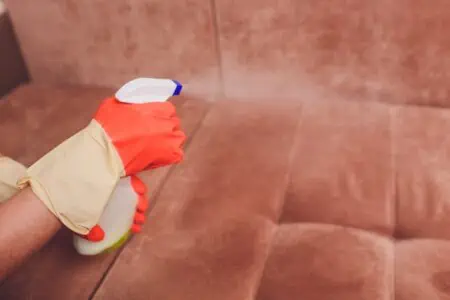A couch in a busy home certainly takes a battering. It provides adults, kids, and pets a place to sit, nap, drink coffee, eat snacks, and more. If your couch is covered in crumbs, stains, and gives off foul odors, it’s time to give it a good clean.
This is where a steam cleaner comes in handy — it’s intended for such rescue missions. Eliminate grime, odors, and difficult stains all at the push of a button.
We’ll walk you through exactly how to steam clean a couch. Follow our step-by-step method and avoid calling in the professionals.
Key Takeaways
- Check couch label for steam cleaning compatibility.
- Vacuum couch thoroughly and pre-treat stains before steaming.
- Use an upholstery steam cleaner for best results.
- Allow couch to dry completely after steam cleaning to avoid mold growth.
How to Steam Clean a Couch
It only takes three main steps to steam clean a couch: vacuuming, steaming, and drying. But there’s a bit more to it. Follow our in-depth guide, and your couch will feel brand new.
- Time: 1.5 hours (plus drying time)
- Difficulty: Interdediate
What You’ll Need
- Vacuum with upholstery attachment
- Stain remover (homemade or store-bought)
- Cloths or scrubbing brush
- Soil emulsifier
- Fabric shampoo
- Steam cleaner for upholstery
1. Preparation Is Key
Before you contemplate this treatment, make sure the label on the couch says it can handle being steam cleaned. It should not have an “X” on it.
Furniture with labels revealing the letters “SW” is solvent and water safe and can be steam cleaned without the risk of damage. An “X” means that water will damage the fabric. So it cannot be steamed and will need a professional clean (1).
Preparing the couch for cleaning is as important as cleaning it. Don’t expect immaculate results if the food is still crushed in or loose dirt is still there.
Vacuum the Couch Thoroughly
Vacuum the furniture well. Get into every crevice, down the sides where dirt can collect, remove cushions, and vacuum each side. Remove any pet hair, crumbs, or trash that could create a problem when steam cleaning.
Also, vacuum the sides and back of the couch, as they need to be cleaned. You’ll be pleasantly surprised when you see the difference in color, even though it might’ve looked clean.
Take your time and use the right tools for the job. Remember, the better the preparation, the better the results.
Pre-Treat Stains
Be very careful when undertaking this. The one thing you don’t need is a lighter piece of upholstery than the rest. So read the manufacturer’s recommendations and information on the label of the cleaning agent before buying. Plus, always test the product in an inconspicuous place on the item (2).
Stains such as urine, feces, food, and dirt can be removed by steam alone. However, anything oil-based needs a pre-treatment cleaner. You should apply it before you start steam cleaning and give it enough time to work its magic.
You could also try a home-based treatment of white vinegar and rubbing alcohol for oil-based stains. Alternatively, use baking soda and cornstarch with water added (3). Don’t scrub too hard to avoid possibly removing color from the material.
How to Treat Old or Set-In Stains
If a further gentle clean won’t remove an old stain, it’s time to get the big guns out. Try a more heavy-duty cleaning agent. However, remember to blot and not rub, as this could worsen the stain.
Again, the heavy-duty cleaner you select should be patch tested in a strategic place on the item of furniture.
Condition the Fabric Before Steaming
The last element of the preparations is to condition the material, so it doesn’t end up hard and gritty. Using such a product as a soil emulsifier on the fabric will help to lift all the components that have been ground in.
Spray the couch with this soil emulsion, ensuring it has seeped into the crevices and down the sides. Leave this to dry for a few minutes, then add a very thin layer of fabric shampoo.
Rub the upholstery firmly with a brush or a clean white cloth, working these chemicals into the fabric.
Take Note
2. Deep Cleaning the Couch
Choose the Right Steam Cleaner
Steam cleaners come in many varieties, with lots of handy attachments. The one you need for cleaning a couch has to be designed for steaming upholstery and fabrics.
An upholstery steam cleaner is specifically made for furniture fabrics. It can be either handheld or a floor machine with attachments. Avoid carpet cleaning machines that boast a tool to clean upholstery. They’re typically cumbersome and don’t work well on couches since they leave them soaking wet.
If you don’t want to buy a steam cleaner, consider hiring one from your local home improvement store.
Prepare the Machine for Cleaning
A benefit of steam cleaners is that you don’t need to use chemical products to get a good clean. Many machines work with just water — either tap or distilled.
Other steam cleaners use a solution of cleaning product diluted with water in order to clean the upholstery thoroughly. The amount of cleaner to water ratio will depend on the machine and cleaning solution you choose. Always follow the diluting ratio instructions to protect your steam cleaner and your couch.
Check your manual to see which attachment to select for the best results. This could be in the form of a brush that remains stationary or possibly a brush that oscillates.
Fill the tank, plug the machine in, and wait for it to come to steam temperature. Don’t try steaming too early as only water will appear, soaking the fabric.
Where to Begin Cleaning
Although you may be tempted to begin with the large frame of the couch, that’s the last part to be cleaned.
First, take any loose cushions and removable pillows and begin with them.
You may only need to steam the one side that is on show. If you need to do both sides, ensure that one side has dried before doing the other. Otherwise, they will take longer to dry and may smell of mold.
Using the steamer, spray the surface of the cushions with steam. Use swift strokes across the whole area of the material.
If there are particularly dirty areas, refrain from holding the steamer in one area for a prolonged time. Instead, repeat the strokes consistently over the whole cushion.
Steam Clean the Large Parts
Now it’s time to move on to the larger areas of the couch and the frame.
You should clean this in small sections at a time. If you do large sections all at once, it gives the water time to soak the fabric. This increases the risk of damage to the upholstery fabric.
You can always repeat the cleaning if there are spots where the dirt is particularly ground in. There’s no need to let it dry first; clean as many times as you need before allowing it to dry.
Take Note
3. Let Your Couch Dry
Drying your couch takes some time which depends on several factors. These include the time of day you choose to steam clean it and the weather. Other factors are how humid the steam was and whether you could get a breeze in the room.
There are ways of speeding the drying process up by using a fan to create the impression of a draft. You could also open a window if the weather is suitable and not humid.
The couch will still dry even if you don’t use any of these methods. It will take time, and the door to the room needs to be left open, so there is no chance for mold to grow (5).
If the stains are still visible, you may need to repeat the process or use a spot cleaner.
How to Remove Persistent Stains
Steam cleaning can remove a wide variety of stains. If you find some are a little more persistent, then there are ways to tackle these without repeating the process.
Begin with the easiest solution of dish soap and water. Dip a sponge in the solution (make sure the sponge does not lose color) and rub to make it soapy.
Squeeze excess water out and blot the stain with the soapy composition. Rinse the sponge and blot the stain with clean water. Do not rub or scrub for fear of damaging the fabric.
If that has no impact, try a white vinegar or apple cider vinegar and water solution. Soak a clean white cloth (any colored cloth will leak color). Then proceed to blot the stain with this solution. You can rub gently in a circular motion, but beware of rubbing and causing more damage.
No white vinegar or apple cider vinegar? No problem — grab some vodka and blot or sprinkle some baking powder over the stain. Leave it for a few hours and vacuum it up.
If nothing of the homemade variety works, you may need to turn to heavy-duty commercialized products.
Some marks have certain products made to suit that type of stain specifically. For that reason, be sure what the stain is in order to buy the correct solution for the problem.
FAQs
Time to Relax
With the step-by-step instructions, your couch should be cleaned to perfection. There’s no need to call in some professional entity that costs an arm and a leg. With precise knowledge and a little elbow grease, you can clean your couch like one fit for a royal.
Ensure you prepare the couch before steaming, and use a machine designed for upholstery. Use quick strokes and repeat over stained areas. Ensure the room is well-ventilated so it can dry.
Then make that well-earned mug of coffee, grab your favorite magazine, and drape yourself over that lovely clean couch.












